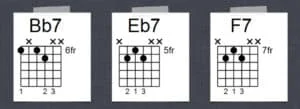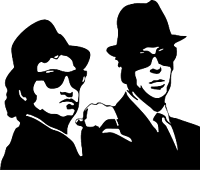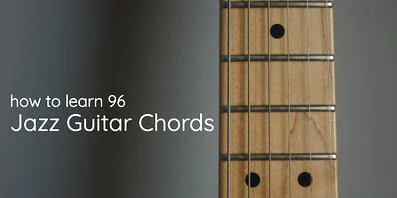The Ultimate Guide to Jazz Guitar Chords: Learn Comping
Mar 22, 2021What is comping?
Comping on guitar is short for "accompanying". This could refer to playing chords behind a vocalist or saxophonist, or even accompanying your own solo with chords on the lower strings.
How to Comp Like a Real Jazz Guitarist
You no longer have to worry about jazz guitar chords! Jazz chord symbols may look like ZIP codes, but they’re totally possible for your fingers to play. You just relax, follow this guide and enjoy the ride. Our ultimate guide - actually, YOUR ultimate guide! - contains everything you’ll need to:
-
Get started with jazz chords and harmony (from the beginning!); or
-
Further refine your comping skills on the guitar
So read on and please make this page a reference! Bookmark it and come back often.

Jazz Guitar Comping Should Be Your #1 Priority
Not just any comping, however. The goal of this whole endeavour is for you to comp good jazz guitar chords on songs (jazz standards — see our list here). Playing the chords in the context of a song is really the best way to learn them.
You’ll discover the true worth of the exercise when you hear it give shape and sound to your favourite tunes. It won’t be long before you see how how vital these songs are to your learning and enjoyment!
When you’re playing with other musicians, you'll be comping most of the time. Therefore, jazz guitar comping becomes your #1 priority! It’s the skill on which you’ll depend the most.
First Step in Jazz Guitar Chords: Beginner Level
Take your time, read through the material slowly, and begin applying these ideas on your guitar. It may take a while to digest everything, and that’s ok! It’s a lifelong process.
Here’s a tip: When you first get started, don’t skim over the basics. Before jumping into a complicated chord melody comping style over a jazz standard — or navigating more intricate chord progressions — you should have a few "chord shells” memorized.
You’ll also want to have some basic chord shapes at your command as well. Get really comfortable with these fundamentals before attempting the more complicated stuff such as using chord substitutions.
In Jazz Guitar, the Basics Inform Everything Else
Ensure you know the basics, and you’ll have a better understanding of what comes later. The underlying building blocks you establish early on will be very valuable once you attempt the fancier ideas.
Remember, be musical and tasteful in your comping! It’s really not about how many chords you know, it’s about how well you use them.
Using a large selection of chord changes or cool chord substitutions works best if the final result SWINGING! So keep it simple, and the rest will follow. Trust me.
Have fun and make good music!
Beginners: How to Read Lead Sheets (Using Chord Shells)
Getting started with jazz guitar chords is pretty easy. In fact, there’s a practical way to play on any jazz standard as an accompanist using only 3-note chords, commonly known as shell voicings.
Shell voicings are easy to play (even easier than barre chords), sound good immediately, and ultimately define the harmony of the song without frills.
Shell voicings are three-note chords: root, 3rd degree, and 7th degree
Here's an example of the three shell chords you'll need to comp on a basic blues in Bb.

When you are reading a lead sheet, you'll often find chords with a 9, 13, and other numbers added. These are known as "extensions."
It's a strange concept to grasp at first, so your job is to always simplify the chords down to their basic 7th form.
For example, if you see Am9, you will play Am7. That means that to get started, there are only three types of shell voicings to learn!
- Minor 7, with m7 or -7 for the symbol (example: Am7)
- Dominant 7, with ONLY a number 7 in the symbol (example: A7)
- Major 7, with maj7 in the symbol (example: Amaj7)
Work through this shell voicings lesson, and come back here when you're done.
Beginners: Learning Basic Jazz Guitar Chord Shapes
Next, we’ll work on the most basic chord shapes on the guitar.
You can think of this like learning the basic E, A, D chord shapes when you first learned to do barre chords. One thing that’s different in jazz music, however, is that the chords almost always have numbers added to them.
You'll find 7, 9, 13, 11, sometimes 6 or even 4.
If you’ve mastered the chord shells above and you've started adding extensions to them, the next logical step would be learning chord shapes.
Here is a formidable jazz guitar chord chart with dozens of useful shapes.
Basic 7th Chords

Many of these chord shapes will become your go-to “grips” because they are all movable on the guitar, just like barre chords. Usually, the root (bass) note is found at the bottom and therefore, it's very easy to transpose.
See the red dot in the picture above (that's the root).
Always try to think of these as you would a barre chord and identify the bass note at first.
For example, if you have a barred G major at the 3rd fret (G), the same shape at the 5th fret is A major. The same concept applies to these guitar chord shapes.
Altered Chords

To wrap up, the first half of this page is mostly for beginners. If you're feeling brave, you can move on to everything else!
And don’t forget — the “chord shells” are always useful, and they’ll remain in your bag of tricks for their simplicity and ease.
In a Hurry to Learn Jazz Guitar Chords?
Learn all these shapes (and more) in one sitting in with this "96 chords in 10 minutes" lesson here:
Beginners: Learn Basic Chord Construction
If you’re a beginner, and you’re interested in music theory, then I urge you to look at all the resources available in the theory section here.
Otherwise, I'll give you the gist of it.
Chords are built in intervals of 3rds. Start by looking at a scale. You start with one note, and skip a note to get the next note in the chord. The first note is “1,” the third note is ”3”
For instance, look at the C major scale.
C D E F G A B
If you want to sound a CMajor7 chord, play only the notes in bold: C D E F G A B. And we say that the CMajor7 chord contains the notes 1-3-5-7. That’s it!
You’ll soon be comfortable with this basic principle, and you’ll also notice there’s more about chords and harmony than just going “up a 3rd.”
Chords used in jazz almost always include four notes, reaching at least up to the 7th. You can always learn more about this in our jazz theory index.
Jazz players also commonly add extensions to chords such as 9, 11 and 13, as explained in the section on adding extensions to chords.
Beginner: Jazz Guitar Chords MILESTONE Test
If you’re just starting out using jazz guitar chords, here’s what you should strive towards during the next 3-6 months:
- Comping shell voicings on 3 standard tunes of your choice
- Being (at least) familiar with comping on II-V-I using shells
Once you're able to do all of the above, you’re ready for the next level! You’re no longer a beginner and you’ll be looking into more advanced comping topics soon. See below and keep reading!
Beginner: What About Rhythm?
Right, great question. What about rhythm?! A good complete “Ultimate Guide” needs to address rhythms — at least some basics.
So often we’re focused on the notes, chords shapes, and chord progressions that we forget the rhythmic component needed to play these ideas!
My take on it is to always play from your heart and let the rhythms flow. Don’t play against the grain, and listen with great focus to whoever you’re accompanying.
Here’s a little something to sink your teeth into. Try these three dependable rhythmic comping ideas:
Four to the floor (aka "chunk chunk chunk" or "poum tchak")

Simply play quarter-notes throughout. Easy enough?
Half-notes (aka "Half-time" or "playing in two")

Simply play in half-notes. Many older musicians call this "playing in two, or will say "let's play in two for the first chorus."
You'll play two half-notes rhythms in each measure, thus the term "two!"
Did you know? You can get creative, and rhythmically displace the half-note rhythm around the bar to create variety.
Click here for a video about this.
The Charleston rhythm (aka "dotted-quarter, eighth")

This is a very common rhythm in (virtually) all music genres. We hear the Charleston rhythm even in ethnic music, hip hop, classical, etc. It’s a very natural rhythmic figure to play.
Did you know? You can take that Charleston figure and displace it around the bar to create an almost infinite amount of rhythmic combinations.
See this video to discover about displacing the Charleston rhythm.
Second Step in Jazz Guitar Chords:
Intermediate Level
As an intermediate player, you’re beginning to know what you are looking for when comping. Your aim is to comp on tunes - lots and lots of tunes.
Your instincts, and rhythmic feel and your chordal vocabulary are improving. Now it’s time to add some more complexity to your playing. Here are some resources to get to work and add some more depth to the harmonic component of your playing.
Intermediate: Comping on Blues
Learning to comp and improvise on blues is an extremely valuable tool for understanding and mastering harmony on the guitar.
See our blues section here for our selection of recommended blues tunes. What’s more, the blues form (in a jazz context) is a great way to start playing with strangers at a jam session.

Words of wisdom: learn to play the blues in several keys, ideally in all of the keys!
I was once sitting in at a jam session and the horn player asked me what I wanted to play. I said: “Db blues”. He immediately replied: “Alright. Gb.” He counted in the band, and he had a huge grin on his face.
True story! So always be prepared for the unexpected Db OR Gb! ;)
Intermediate: Diatonic and Altered Chords
As an intermediate player, it’s a great idea to launch yourself into learning some altered chords. You’ve seen these on lead sheets and in fake books. Some of the chords look like ZIP codes!
Take, for example, G7#9b5 or simply G7alt. These chords contain multiple altered extensions on a dominant chord.
You can find these charts on this page.
There is a lot of color to be found using these types of chords. The alterations are interchangeable, so learn as many as you can. Then you can choose which ones are right for the situation.
More Altered Chords

Another great way to learn lots of chords efficiently is to understand their origins. If you're starting to get into the hip, modern stuff, this is an important step.
The origins are simple: these chords come from within scales!
Earlier, I suggested that we might just pass over some of theory information. Now that things are getting more advanced, it’s a good idea to have a closer look at how all these fancy chords are developed. We also use the term diatonic chords a lot.
The term “diatonic” means “according to the tonic.” Therefore, chords that are derived from a scale are deemed “diatonic” to that scale.
Here’s an interesting article covering the seven diatonic chords from three important scales. There are 21 chords in total, and they’ve been extracted from the major, melodic minor and harmonic minor scales.
Intermediate: Stepping Up to Rootless chords
After "graduating" from being a beginner and entering the intermediate level comping world, it's a great idea to explore jazz guitar chords that don't use the root as the bass note.
A practical introductory way to do so is to assemble and play the inversions of typical chord qualities (Maj7, min7, etc.) on the top strings of the guitar.
This is exactly what's happening in the Drop 2 Challenge for Jazz Guitarists. You'll learn to work through all the inversions of all drop 2 chords onto two string set.
It's worth taking a look!
Intermediate: Curious About Chord Melody?
If you’ve been comping for long enough, you’re probably starting to explore the world of chord melody playing.
It’s fantastic stuff, and doing so will improve your comping significantly. It’s not the topic of the current post, but here’s a great place to get started. Your first steps into chord melody: the FREE 7-day course on Summertime.
Intermediate: Theory and Understanding
As you gain more experience with jazz guitar comping, you’ll want to add new layers to your practice.
Here are three great places to gather information on the topic of the inner workings of jazz chords and chord progressions.
- Beginner's Guide to Jazz Chord Progressions - A guide to understanding chord progressions and their functionality. Do make sure to read all of the accompanying instructions!
- No-Nonsense Guide to Jazz Harmony (and Beyond) - This post hopes to answer ALL basic questions relating to harmony and theory in one place.
- A Gentle Introduction to Guitar Chord Theory - A guide to understanding chord construction from the triad level all the way up to extended chords.
Intermediate: Jazz Guitar Chords MILESTONE Test
If you want to consider yourself an intermediate at jazz guitar comping, here’s some of the skills you should master:
- Comping with shell voicings on any standard while sight reading the chord symbols.
- Know some (or a lot) of altered and extended chords
- Being able to use at least some rootless voicings (for instance, on II-V-I)
- Lastly, getting a deeper understanding of chord progressions found in songs (beyond the II-V-I)
How are you doing? If you’re still working on the skills described above, I recommend you stop reading here. The following tips are for guitarists that are a bit more advanced. See you soon! ;)
Third Step in Jazz Guitar Chords:
Advanced and Beyond
Below you’ll find the best resources to take your comping and playing to the next level.
Because you're a more experienced jazz guitarist, you'll have to devise your own ways to “divide and conquer” this material. It’s a lifelong journey, so take your time and enjoy the ride!
**Note from the editor** This post was updated on 05/17/2019 to improve quality and readability.
**Note from the editor**This post was updated 03/24/2021. Image, introduction and layout updates.












